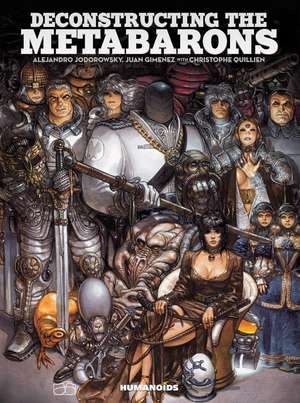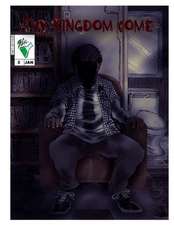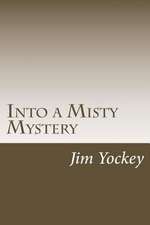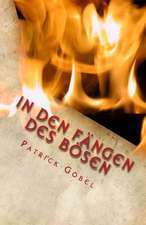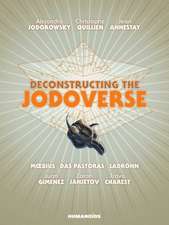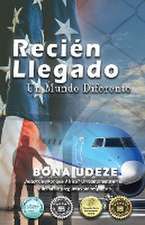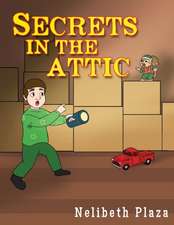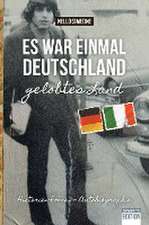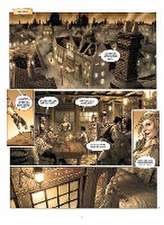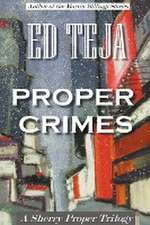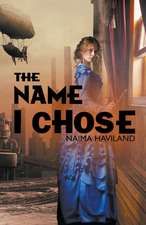Deconstructing the Metabarons: Oversized Deluxe
Autor Christophe Quillien Alejandro Jodorowsky, Juan Gimenez, Moebiusen Limba Engleză Hardback – 26 mar 2019
Deconstructing the Metabarons sheds light on the secrets surrounding the celestial clan of warriors, first introduced in the the seminal science-fiction graphic novel, which has become the cornerstone of the Jodoverse, The Incal. This encyclopedic reference book is packed with fascinating insights from the Metabaron's original creators, Jodorowsky and Mœbius, alongside revealing text, and rare and unseen preliminary illustrations from Juan Gimenez. Discover the complexities of the Metabarons' sacred bloodline, traveling all the way their inception, through the tales of the intricacies of the expanded Universe and into the recent relaunch, The Metabaron.
Preț: 113.77 lei
Preț vechi: 133.88 lei
-15% Nou
Puncte Express: 171
Preț estimativ în valută:
21.78€ • 23.66$ • 18.30£
21.78€ • 23.66$ • 18.30£
Carte disponibilă
Livrare economică 04-16 aprilie
Livrare express 15-21 martie pentru 73.05 lei
Preluare comenzi: 021 569.72.76
Specificații
ISBN-13: 9781594656484
ISBN-10: 1594656487
Pagini: 128
Ilustrații: Color Throughout
Dimensiuni: 239 x 320 x 15 mm
Greutate: 1.04 kg
Editura: Humanoids, Inc.
Colecția Humanoids, Inc.
Locul publicării:United States
ISBN-10: 1594656487
Pagini: 128
Ilustrații: Color Throughout
Dimensiuni: 239 x 320 x 15 mm
Greutate: 1.04 kg
Editura: Humanoids, Inc.
Colecția Humanoids, Inc.
Locul publicării:United States
Notă biografică
When he was little, Christophe Quillien dreamed of being a superhero. Alas, he quickly realized that life had given him a single super-power: writing. Since then, he has busied himself by writing books on comics. He published Grandes aventurières et femmes fatales de la bande dessinée (Huginn & Muninn), Méchants, crapules et autres vilains de la bande dessinée (Huginn & Muninn), La Bande dessinée (Gallimard Jeunesse), Le Guide des 100 bandes dessinées incontournables (Librio), La Bande dessinée à Paris (Parigramme). Il a aussi écrit des articles sur la BD (et d’autres sujets moins sérieux) dans la presse: The Good Life, Rolling Stone, Epok, Le Magazine Littéraire, Le Monde, Les Inrockuptibles, Télérama Sortir… He has also written articles about comics (and other less serious topics) in the press: The Good Life, Rolling Stone, Epok, The Literary Magazine, The World, Inrockuptibles, Télérama Sortir ...
Alejandro Jodorowsky Prullansky (Spanish: [xoðo'?ofski]; born 17 February 1929) is a Chilean and French avant-garde filmmaker. Best known for his films El Topo (1970), The Holy Mountain (1973) and Santa Sangre (1989), Jodorowsky has been "venerated by cult cinema enthusiasts" for his work which "is filled with violently surreal images and a hybrid blend of mysticism and religious provocation".[1]
Born to Jewish-Ukrainian parents in Chile, Jodorowsky experienced an unhappy and alienated childhood, and so immersed himself in reading and writing poetry. Dropping out of college, he became involved in theater and in particular mime, working as a clown before founding his own theater troupe, the Teatro Mimico, in 1947. Moving to Paris in the early 1950s, Jodorowsky studied traditional mime under Étienne Decroux, and put his miming skills to use in the silent film Les têtes interverties (1957), directed with Saul Gilbert and Ruth Michelly. From 1960 onwards he divided his time between Mexico City and Paris, where he co-founded Panic Movement, a surrealist performance art collective that staged violent and shocking theatrical events. In 1966 he created his first comic strip, Anibal 5, and in 1967 he directed his first feature film, the surrealist Fando y Lis, which caused a huge scandal in Mexico, eventually being banned.
His next film, the acid western El Topo (1970), became a hit on the midnight movie circuit in the United States, considered the first-ever midnight cult film, and garnered high praise from John Lennon, who convinced former Beatles manager Allen Klein to provide Jodorowsky with $1 million to finance his next film. The result was The Holy Mountain (1973), a surrealist exploration of western esotericism. Disagreements with Klein, however, led to both The Holy Mountain and El Topo failing to gain widespread distribution, although both became classics on the underground film circuit.[1] After a cancelled attempt at filming Frank Herbert's 1965 science fiction novel Dune, Jodorowsky produced five more films: the family film Tusk (1980); the surrealist horror Santa Sangre (1989); the failed blockbuster The Rainbow Thief (1990); and the first two films in a planned five-film autobiographical series The Dance of Reality (2013) and Endless Poetry (2016).
Jodorowsky is also a comic book writer, most notably penning the science fiction series The Incal throughout the 1980s, which has been described as having a claim to be "the best comic book" ever written.[2] Other comic books he has written include The Technopriests and Metabarons. Jodorowsky has also extensively written and lectured about his own spiritual system, which he calls "psychomagic" and "psychoshamanism", which borrows from alchemy, the tarot, Zen Buddhism and shamanism.[3] His son Cristóbal has followed his teachings on psychoshamanism; this work is captured in the feature documentary Quantum Men, directed by Carlos Serrano Azcona.[4]
Born November 26th, 1943 in Mendoza, Argentina.
Gimenez finished his high school education as an industrial design major and advanced his artistic education by attending the Academy of Fine Arts in Barcelona, Spain, where he studied drawing. For the next few years, he dedicated himself to the drawing of comic books, both back in his native Argentina with such publishers as Colomba and Record, as well as in Spain, contributing to magazines such as Zona 84, and Comix International. By this point, Gimenez had made quite a name for himself for his extremely detailed renditions of machinery, chiefly in the war and science fiction genres. His art further propelled him to international collaborations, and it was in 1979 that he was first published in France with a series of titles including “Leo Roa," which he also wrote. The following year, he participated, as a creative designer, on a segment of the film “Heavy Metal." For the next decade, he continued his work in comic book magazines, notably the French comics anthology Metal Hurlant and the Italian L'Eternauta.
The 1990s saw him strengthening his fan base as he was repetitively voted best artist by European audiences, a recognition that was mirrored in the festival and critical realms, with such awards as the Gaudi award at the Feria Internacional del Comics de Barcelone, in 1990. In 1992, he meets Alejandro Jodorowsky for the first time, and the two began work on “The Metabarons," a sci-fi saga of epic proportions in both art and story. It is to this day regarded as one of the true graphic novel classic of the genre and it continues successful sales around the world.
Gimenez currently maintains a consistent yet varied workload, lending his talents as illustrator to covers for CD albums and novels, as well as serving as a concept artist on video games, and motion pictures. He also remains in high demand as a graphic novel artist, collaborating with some of Europe's most acclaimed authors such as Carlos Trillo, Emilio Balcarce, and Roberto Dal Prà, when he is not writing his own stories as he successfully continues to do, as with “The Fourth Power" collection.
On April 2nd, 2020, he passed away in his home province of Mendoza, Argentina, from COVID-19 complications.
Web sites:+ http://www.juangimenez.com/
Jean Henri Gaston Giraud (French: [?i?o]; 8 May 1938 – 10 March 2012) was a French artist, cartoonist, and writer who worked in the Franco-Belgian bandes dessinées (BD) tradition. Giraud garnered worldwide acclaim predominantly under the pseudonym Mœbius (/'mo?bi?s/;[1] French: [møbjys]) for his fantasy/science-fiction work, and to a slightly lesser extent as Gir (French: [?i?]), which he used for the Blueberry series and his other Western-themed work. Esteemed by Federico Fellini, Stan Lee, and Hayao Miyazaki, among others,[2] he has been described as the most influential bande dessinée artist after Hergé.[3]
His most famous body of work as Gir concerns the Blueberry series, created with writer Jean-Michel Charlier, featuring one of the first antiheroes in Western comics, and which is particularly valued in continental Europe. As Mœbius, he achieved worldwide renown (in this case in the English-speaking nations and Japan, as well – where his work as Gir had not done well), by creating a wide range of science-fiction and fantasy comics in a highly imaginative, surreal, almost abstract style. These works include Arzach and the Airtight Garage of Jerry Cornelius. He also collaborated with avant garde filmmaker Alejandro Jodorowsky for an unproduced adaptation of Dune and the comic-book series The Incal.
Mœbius also contributed storyboards and concept designs to numerous science-fiction and fantasy films, such as Alien, Tron, The Fifth Element, and The Abyss. Blueberry was adapted for the screen in 2004 by French director Jan Kounen
Alejandro Jodorowsky Prullansky (Spanish: [xoðo'?ofski]; born 17 February 1929) is a Chilean and French avant-garde filmmaker. Best known for his films El Topo (1970), The Holy Mountain (1973) and Santa Sangre (1989), Jodorowsky has been "venerated by cult cinema enthusiasts" for his work which "is filled with violently surreal images and a hybrid blend of mysticism and religious provocation".[1]
Born to Jewish-Ukrainian parents in Chile, Jodorowsky experienced an unhappy and alienated childhood, and so immersed himself in reading and writing poetry. Dropping out of college, he became involved in theater and in particular mime, working as a clown before founding his own theater troupe, the Teatro Mimico, in 1947. Moving to Paris in the early 1950s, Jodorowsky studied traditional mime under Étienne Decroux, and put his miming skills to use in the silent film Les têtes interverties (1957), directed with Saul Gilbert and Ruth Michelly. From 1960 onwards he divided his time between Mexico City and Paris, where he co-founded Panic Movement, a surrealist performance art collective that staged violent and shocking theatrical events. In 1966 he created his first comic strip, Anibal 5, and in 1967 he directed his first feature film, the surrealist Fando y Lis, which caused a huge scandal in Mexico, eventually being banned.
His next film, the acid western El Topo (1970), became a hit on the midnight movie circuit in the United States, considered the first-ever midnight cult film, and garnered high praise from John Lennon, who convinced former Beatles manager Allen Klein to provide Jodorowsky with $1 million to finance his next film. The result was The Holy Mountain (1973), a surrealist exploration of western esotericism. Disagreements with Klein, however, led to both The Holy Mountain and El Topo failing to gain widespread distribution, although both became classics on the underground film circuit.[1] After a cancelled attempt at filming Frank Herbert's 1965 science fiction novel Dune, Jodorowsky produced five more films: the family film Tusk (1980); the surrealist horror Santa Sangre (1989); the failed blockbuster The Rainbow Thief (1990); and the first two films in a planned five-film autobiographical series The Dance of Reality (2013) and Endless Poetry (2016).
Jodorowsky is also a comic book writer, most notably penning the science fiction series The Incal throughout the 1980s, which has been described as having a claim to be "the best comic book" ever written.[2] Other comic books he has written include The Technopriests and Metabarons. Jodorowsky has also extensively written and lectured about his own spiritual system, which he calls "psychomagic" and "psychoshamanism", which borrows from alchemy, the tarot, Zen Buddhism and shamanism.[3] His son Cristóbal has followed his teachings on psychoshamanism; this work is captured in the feature documentary Quantum Men, directed by Carlos Serrano Azcona.[4]
Born November 26th, 1943 in Mendoza, Argentina.
Gimenez finished his high school education as an industrial design major and advanced his artistic education by attending the Academy of Fine Arts in Barcelona, Spain, where he studied drawing. For the next few years, he dedicated himself to the drawing of comic books, both back in his native Argentina with such publishers as Colomba and Record, as well as in Spain, contributing to magazines such as Zona 84, and Comix International. By this point, Gimenez had made quite a name for himself for his extremely detailed renditions of machinery, chiefly in the war and science fiction genres. His art further propelled him to international collaborations, and it was in 1979 that he was first published in France with a series of titles including “Leo Roa," which he also wrote. The following year, he participated, as a creative designer, on a segment of the film “Heavy Metal." For the next decade, he continued his work in comic book magazines, notably the French comics anthology Metal Hurlant and the Italian L'Eternauta.
The 1990s saw him strengthening his fan base as he was repetitively voted best artist by European audiences, a recognition that was mirrored in the festival and critical realms, with such awards as the Gaudi award at the Feria Internacional del Comics de Barcelone, in 1990. In 1992, he meets Alejandro Jodorowsky for the first time, and the two began work on “The Metabarons," a sci-fi saga of epic proportions in both art and story. It is to this day regarded as one of the true graphic novel classic of the genre and it continues successful sales around the world.
Gimenez currently maintains a consistent yet varied workload, lending his talents as illustrator to covers for CD albums and novels, as well as serving as a concept artist on video games, and motion pictures. He also remains in high demand as a graphic novel artist, collaborating with some of Europe's most acclaimed authors such as Carlos Trillo, Emilio Balcarce, and Roberto Dal Prà, when he is not writing his own stories as he successfully continues to do, as with “The Fourth Power" collection.
On April 2nd, 2020, he passed away in his home province of Mendoza, Argentina, from COVID-19 complications.
Web sites:+ http://www.juangimenez.com/
Jean Henri Gaston Giraud (French: [?i?o]; 8 May 1938 – 10 March 2012) was a French artist, cartoonist, and writer who worked in the Franco-Belgian bandes dessinées (BD) tradition. Giraud garnered worldwide acclaim predominantly under the pseudonym Mœbius (/'mo?bi?s/;[1] French: [møbjys]) for his fantasy/science-fiction work, and to a slightly lesser extent as Gir (French: [?i?]), which he used for the Blueberry series and his other Western-themed work. Esteemed by Federico Fellini, Stan Lee, and Hayao Miyazaki, among others,[2] he has been described as the most influential bande dessinée artist after Hergé.[3]
His most famous body of work as Gir concerns the Blueberry series, created with writer Jean-Michel Charlier, featuring one of the first antiheroes in Western comics, and which is particularly valued in continental Europe. As Mœbius, he achieved worldwide renown (in this case in the English-speaking nations and Japan, as well – where his work as Gir had not done well), by creating a wide range of science-fiction and fantasy comics in a highly imaginative, surreal, almost abstract style. These works include Arzach and the Airtight Garage of Jerry Cornelius. He also collaborated with avant garde filmmaker Alejandro Jodorowsky for an unproduced adaptation of Dune and the comic-book series The Incal.
Mœbius also contributed storyboards and concept designs to numerous science-fiction and fantasy films, such as Alien, Tron, The Fifth Element, and The Abyss. Blueberry was adapted for the screen in 2004 by French director Jan Kounen
Descriere
The second reference guide to the Jodoverse, focused on unveiling the secrets of the Universe's fiercest warrior clan: the Metabarons.
